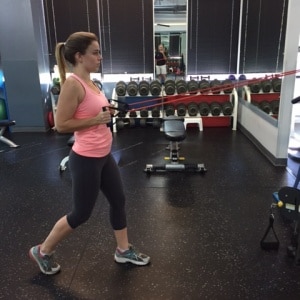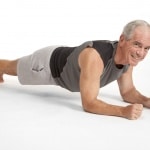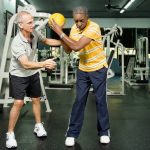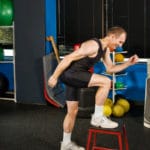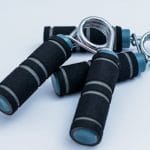 January 2024
January 2024
Free Weights vs Machines: Is There a Difference?
Ever since Nautilus gym equipment hit the market in the 1970s, the burning question among fitness specialists and researchers was, Can you get as strong and/or as hypertrophied on machine resistance (MR) devices as you can using free weights (FW) like dumbbells and barbells? When Nautilus came out, they did their own research “proving” MR was as good if not better than FW, and more time efficient. But does this bias hold water, so to speak?
Over the past 50 years, the bias against MR centered around the reality that FW demanded more muscle activation in muscle groups that do the work and stabilize the specific joint plus the body. MR so isolated the joint or joints being exercised that the body failed to adapt to movements since it was stabilized in the seat and trunk support structures.
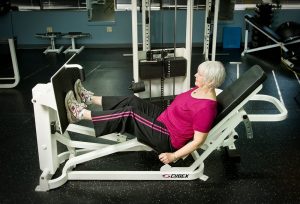
A study from Spain compared MR to FW for strength, muscle growth, and joint discomfort in an 8-wk, 2/wk, exercise-matched, progressive weight training program in two groups of young males. The exercises were full squat vs leg press; bench vs chest press; prone bench row vs seated row; and FW vs MR overhead press.
Each group got stronger, especially on the device upon which they trained, as expected. However, strength gains were statistically equivalent. Likewise, muscle growth was similar between groups. And there were no differences between the groups on stiffness, pain, and functional disability levels.
This means lift against a resistaance by whatever method you want or feels right for you, and get stronger as safely as your fellow gym-goers. But you have to do some resistance work at least twice a week for health and fitness.
MSSE Dec. 2023
Does Pre-Hab Before Knee or Hip Replacement Work?
When someone has made the decision to get a knee or hip replacement, having been dealing with pain and disability for quite some time, it makes intuitive sense that doing some structured exercises beforehand would prepare the muscles, tendons, and neuromuscular system for the day after. This is called prehabilitation, or prehab for short.
A multi-center meta-analysis tried to determine if prehab helps increase strength, reduce length of hospital or rehab center stay, improve range of motion (ROM), decrease post-surgery pain, and improve activities of daily living (ADL). A group of experts assessed the quality of studies of controlled trials of prehab’s benefits and combined the data to assess the strength of evidence.
They determined that the “large heterogeneity [differences in prehab programs] across evaluated prehabilitation programs limited strong conclusions, [but that the] evidence from 13 total knee arthroplasty randomized controlled trials suggest that prehabilitation may result” in increased strength, reduced length of stay and improved ADLs while not increasing pain, detracting from ROM.
Due to the vast differences in prehab programs, they also concluded that there was no or insufficient evidence “for all other outcomes” after knee and hip replacements. Of course, let it be said that many of these prehab plans were minimalist in nature, focused mainly on the joint to be replaced, and only with exercises that could be considered generic and traditional. There are good arguments to be made that something is better than nothing as you prepare for a joint replacement but something more comprehensive, which has not been tested, is better than the bare minimum.
And don’t forget to add protein to your diet before and after the surgery. It helps to minimize atrophy.
Amer Journal of Physical Medicine and Rehabilitation Jan. 2023
Tid Bits
A study of nearly 90,000 adults (avg. age 62) who wore physical activity trackers for a week allowed Harvard researchers to gage levels of activity in reference to rates of cardiovascular diseases over the next 6 years. They found 3 patterns of activity: weekend warriors, weekly regulars, and inactive. The weekend warriors and regular exercisers had similar and lower rates of disease, strokes, heart attacks, etc. Harvard Women’s Health Watch, Dec. 2023
A meta-analysis by Swedish and Italian researchers looked at rates of re-injury among anterior cruciate ligament (ACL)-repair patients in the context of how soon they returned to their respective sports. Nearly 17% suffered a second ACL tear with the data showing that those who returned earlier had higher rates of reinjury: at 8.7 months vs 9.1 months post-surgery. That’s a difference of less than one-half of a month, suggesting that a mere 2 extra weeks of therapy might prevent athletes from tearing the same or even the other ACL. A 9-month delay has been shown elsewhere to be worth the wait. JOSPT Nov. 2023
It’s long been known that pain, inflammation, injury, and disuse lead to muscle atrophy at the site of injury. But a Dutch study aimed to assess the effect of temporary immobilization with subsequent re-mobilization in order to evaluate the changes in muscle connective protein synthesis in healthy, young adults. After a week of unilateral casting, subjects were followed for 2 weeks of ‘ambulant recovery’, or walking. Muscle biopsies as well as “mRNA expression of key extracellular matrix proteins” were measured. Protein synthesis was lower during the study week but bounced back once recovery resumed. This explains why many musculoskeletal medical and fitness professionals promote extra protein intake and muscle activation protocols before and during recovery periods after surgery or injury. MSSE Nov. 2023


